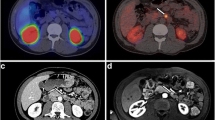Abstract
Purpose
Contrast-enhanced CT (CECT) is a standard investigative procedure in the localization of gastrinomas. Small tumors are often missed and metastatic lesions may remain occult on CT. The purpose of present study was to prospectively evaluate the diagnostic performance of 68Ga-labeled [1,4,7,10-tetraazacyclododecane-1,4,7,10-tetraacetic acid]-1-NaI3-Octreotide (68Ga-DOTANOC) positron emission tomography/computed tomography (PET/CT) in gastrinoma patients with negative or equivocal CT findings.
Methods
Twenty-five patients (age 46.6 ± 13.3 years; male 60%) with clinical/biochemical diagnosis of gastrinoma and negative or equivocal findings on CECT were prospectively evaluated. All of them underwent 68Ga-DOTANOC PET/CT which was evaluated by two nuclear medicine physicians in consensus. Combination of histopathology, serum gastrin, endoscopy, and follow-up imaging were taken as reference standard.
Results
68Ga-DOTANOC PET/CT was positive in 17 patients and negative in 8 patients, yielding an overall detection rate of 68%. It was positive 13/20 patients who underwent baseline evaluation and in 4/5 post-treatment patients. Of the 11 patients who had a negative CT result, 68Ga-DOTANOC PET/CT was positive in four cases (detection rate 36.4%), while it was abnormal in 13/14 patients who had equivocal CT findings (detection rate 92.8%). Diagnostic performance of 68Ga-DOTANOC PET/CT was superior in patients with equivocal CECT findings than that in patients with negative CECT (P = 0.010).
Conclusion
68Ga-DOTANOC PET/CT appears to be useful in patients with gastrinoma with negative or equivocal results on CECT, especially the latter group.




Similar content being viewed by others
References
Wise SR, Johnson J, Sparks J, et al. (1989) Gastrinoma: the value of preoperative localization. Surgery 106:1087–1093
Frucht H, Doppman JL, Norton JA, et al. (1989) MR imaging of gastrinomas: comparison with computed tomography, angiography and ultrasound. Radiology 171:713–717
Imamura M, Takahasi K, Adachi H, et al. (1987) Usefulness of selective arterial secretin injection test for localization of gastrinoma in the Zollinger–Ellison syndrome. Ann Surg 205:230–239
Rosch T, Lightdale CJ, Botet JF (1992) Localization of pancreatic endocrine tumors by endoscopic ultrasonography. N Engl J Med 326:1721–1726
Kvols LK (1993) Somatostatin-receptor imaging of human malignancies: a new era in the localization, staging, and treatment of tumors. Gastroenterology 105:1909–1914
de Kerviler E, Cadiot G, Lebtahi R, et al. (1994) Somatostatin receptor scintigraphy in forty-eight patients with the Zollinger–Ellison syndrome. GRESZE: groupe d’Etude du syndrome de Zollinger–Ellison. Eur J Nucl Med 21:1191–1197
Gibril F, Reynolds JC, Doppman JL, et al. (1996) Somatostatin receptor scintigraphy: its sensitivity compared with that of other imaging methods in detecting primary and metastatic gastrinomas. A prospective study. Ann Intern Med 125:26–34
Antunes P, Ginj M, Zhang H, et al. (2007) Are radiogallium-labelled DOTA-conjugated somatostatin analogues superior to those labelled with other radiometals? Eur J Nucl Med Mol Imaging 34:982–993
Buchmann I, Henze M, Engelbrecht S, et al. (2007) Comparison of 68 Ga-DOTATOC PET and 111In-DTPAOC (octreoscan) SPECT in patients with neuroendocrine tumours. Eur J Nucl Med Mol Imaging 34:1617–1626
Kowalski J, Henze M, Schuhmacher J, et al. (2003) Evaluation of positron emission tomography imaging using 68Ga-DOTA-D Phe(1)-Tyr(3)-Octreotide in comparison to 111In-DTPAOC SPECT. First results in patients with neuroendocrine tumors. Mol Imaging Biol 5:42–48
Gabriel M, Decristoforo C, Kendler D, et al. (2007) 68Ga-DOTA-Tyr3-octreotide PET in neuroendocrine tumors: comparison with somatostatin receptor scintigraphy and CT. J Nucl Med 48:508–518
Naswa N, Sharma P, Kumar A, et al. (2011) Gallium-68-DOTA-NOC PET/CT of patients with gastroenteropancreatic neuroendocrine tumors: a prospective single-center study. AJR Am J Roentgenol 197:1221–1228
Kumar R, Sharma P, Garg P, et al. (2011) Role of (68)Ga-DOTATOC PET–CT in the diagnosis and staging of pancreatic neuroendocrine tumours. Eur Radiol 21:2408–2416
Versari A, Camellini L, Carlinfante G, et al. (2010) Ga-68 DOTATOC PET, endoscopic ultrasonography, and multidetector CT in the diagnosis of duodenopancreatic neuroendocrine tumors: a single-centre retrospective study. Clin Nucl Med 35:321–328
Zhernosekov KP, Filosofov DV, Baum RP, et al. (2007) Processing of generator-produced 68Ga for medical application. J Nucl Med 48:1741–1748
Ambrosini V, Campana D, Bodei L, et al. (2010) 68Ga-DOTA-NOC PET/CT clinical impact in patients with neuroendocrine tumors. J Nucl Med 51:669–673
Naswa N, Sharma P, Kumar A, et al. (2012) 68Ga DOTANOC PET/CT in patients with carcinoma of unknown primary of neuroendocrine origin. Clin Nucl Med 37:245–251
Norton JA, Doppman JL, Jensen RT (1992) Curative resection in Zollinger–Ellison syndrome: results of a 10-year prospective study. Ann Surg 215:8–18
Fraker DL, Norton JA, Alexander HR, et al. (1994) Surgery in Zollinger–Ellison syndrome alters the natural history of gastrinoma. Ann Surg 220:320–330
Stabile BE, Passaro E Jr (1985) Benign and malignant gastrinoma. Am J Surg 49:144–150
Weber HC, Venzon DJ, Lin JT, et al. (1995) Determinants of metastatic rate and survival in patients with Zollinger–Ellison syndrome: a prospective long-term study. Gastroenterology 108:1637–1649
Ellison EH, Wilson SD (1964) The Zollinger–Ellison syndrome: re-appraisal and evaluation of 260 registered cases. Ann Surg 160:512–530
Putzer D, Gabriel M, Henninger B, et al. (2009) Bone metastases in patients with neuroendocrine tumor: 68Ga-DOTA-Tyr3-octreotide PET in comparison to CT and bone scintigraphy. J Nucl Med 50:1214–1221
Jensen RT (1996) Gastrinoma. Bailliere’s Clin Gastroenterol 10:603–643
Banasch M, Schmitz F (2007) Diagnosis and treatment of gastrinoma in the era of proton pump inhibitors. Wien Klin Wochenschr 119:573–578
Jais P, Mignon M (1995) Normal serum gastrin concentration in gastrinoma. Lancet 346:1421–1422
Yanda RJ, Ostroff JW, Ashbaugh CD, et al. (1989) Zollinger–Ellison syndrome in a patient with normal screening gastrin level. Dig Dis Sci 34:1929–1932
Wolfe MM, Jain DK, Edgerton JR (1985) Zollinger–Ellison syndrome associated with persistently normal fasting serum gastrin concentrations. Ann Intern Med 103:215–217
Conflict of interest
The authors declare that there is no conflict of interest.
Author information
Authors and Affiliations
Corresponding author
Rights and permissions
About this article
Cite this article
Naswa, N., Sharma, P., Soundararajan, R. et al. Diagnostic performance of somatostatin receptor PET/CT using 68Ga-DOTANOC in gastrinoma patients with negative or equivocal CT findings. Abdom Imaging 38, 552–560 (2013). https://doi.org/10.1007/s00261-012-9925-z
Published:
Issue Date:
DOI: https://doi.org/10.1007/s00261-012-9925-z




